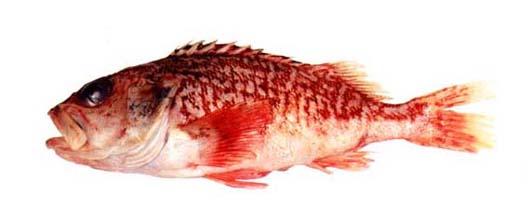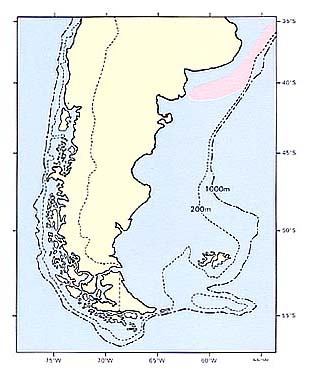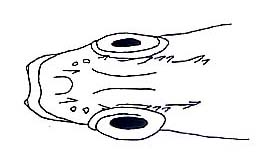フサカサゴ科
- HOME
- デジタル図鑑
- パタゴニア海域の重要水族
- 硬骨魚綱 カサゴ目
- フサカサゴ科
フサカサゴ科(Scorpaenidae)

61 ラプラタユメカサゴ(Rapurata-yumekasago)
Helicolenus dactylopterus lahillei (Norman, 1937)
Rubio (Arg.)
アラカブ(業界名)
特 徴:
背鰭12棘,12軟条,臀鰭3棘,5軟条,胸鰭19軟条,腹鰭1棘,5軟条,側線鱗数57~61,鰓耙数7~8+18-20=25~27。体長に対する体高の割合は31.8~35.3%,頭長は35.8~38.1%,眼径は9.0~11.0%,両眼間隔は4.8~5.2%,吻長は8.6~9.6%,上顎長は18.4~19.7%,尾柄高は9.3~10.5%,背鰭前長は33.6~36.2%,胸鰭前長は32.3~36.2%。体は長楕円形で体高が高く,側扁する。両鼻孔は眼の前上方にあり,互いに接近し鼻管を形成する。眼隔域はくぼみ,その両側に多数の小さくて鋭い棘が発達する。口は大きく,上顎の後端は眼の中央よりやや後下方に達する。下顎は上顎よりわずかに突出し,先端下面に小さなコブ状突起がある。両顎歯は絨毛状で歯帯を形成する。鋤骨,口蓋骨にも歯がある。眼の下方に眼下骨床が発達する。前鰓蓋骨に5本の,主鰓蓋骨に2本の棘がある。眼前骨下縁に棘はない。胸鰭後縁の上部は斜めに截型。尾鰭後縁はわずかにくぼむ。吻は無鱗。主上顎骨後部,鰓膜および背鰭軟条部基底は被鱗する。胸鰭は下方の6~8軟条の先端が遊離する。体の背方は橙赤色で,朱赤色の不規則な斑紋がある。体の下方は桃色。背鰭の鰭膜に暗赤色の斑紋がある。胸鰭,腹鰭および臀鰭は赤色。
分 布:
ウルガイからアルゼンチン北部の南緯40度まで,沿岸の水深80~200mに分布する。
備 考:
本種はヨーロッパに分布するH. dactylopterusとされていたが,Norman (1937)により別種H. lahilleiとされた。ここではRinguelet and Aramburu (1960)の見解に従い,H. dactylopterusの亜種とした。本種に近縁のH. maculatusが南アフリカに,H. papilosusがニュージーランドに分布する。
(稲田伊史)
Material examined:
4 from Argentina (144.6-279.2 mm SL), FSFL EM 465, 604; EL 744, 866.
Description:
D ⅩⅡ, 12; A Ⅲ, 5; P119; P2 Ⅰ, 5; LLS 57-61; GR 7-8+18-20=25-27. HL 35.8-38.1% of SL; ED 9.0-11.0; BD 31.8-35.3; SN 8.6-9.6; IO 4.8-5.2; UJ 18.4-19.7; CP 9.3-10.5; PreD 33.6-36.2; PreP1 32.3-36.2.
Body rhomboidal and slightly compressed. Both anterior and posterior nostrils with tubes, situated close together anterior to upper part of eye. Interorbital slightly concave, many small strong spines developed along both edges. Mouth large, posterior end of upper jaw extending below middle of eye. Lower jaw projecting slightly further than upper and a small knob present on chin. Teeth on both jaws forming villiform bands; vomer and palatines toothed. Strong bony ridge developed below eye. Five spines on preopercle and 2 spines on opercle. No spine on lower margin of preorbital. Upper part of pectoral margin truncate obliquely. Caudal margin slightly concave. Snout scaleless; end of upper jaw, fin membranes and base of second dorsal fin scaled. Six to 8 lowermost rays of pectoral simple. Upper part of body orange-red; side more or less spotted or mottled with vermilion color; lower part pinkish white; dorsal fin membranes with dark spots and blotches; pectoral, pelvic and anal fins reddish.
Distribution:
From Uruguay to northern part of Argentina (to 40°S) in 80-200 m depths.
Remarks:
This species has been confused with H. dactylopterus known from Europe, but Norman (1937) identified the former as a separate species, H. lahillei. I have considered this as a subspecies of H. dactylopterus following Ringuelet and Aramburu (1960). Closely related species, H. maculatus and H. papillosus are distributed in South Africa and New Zealand respectively.
(Tadashi INADA)

Distribution of Helicolenus dactylopterus lahillei in Patagonia.

Head in dorsal view.